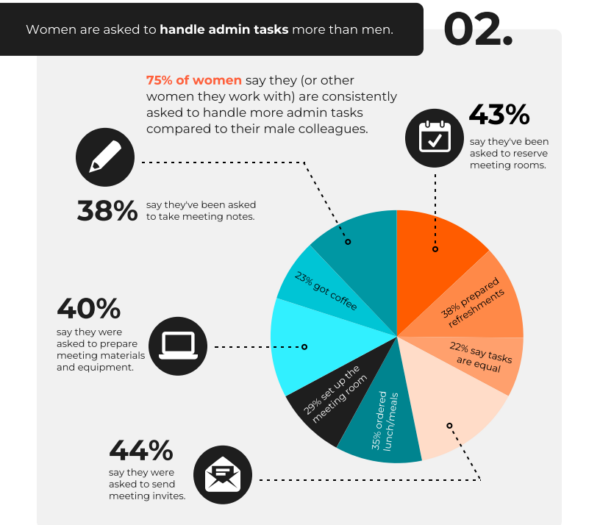Women shoulder extra emotional labor at home and at work. You can help.
Women often feel pressure to shoulder invisible, intangible tasks that take a toll on their home and work lives.

The mental load is a popular term for the extra work that women carry in maintaining a family and household. It’s a combination of cognitive and emotional labor, according to BBC’s Worklife.
The mental load could be anything from maintaining a mental grocery list, remembering when the kids need to be picked up or always being the one to notice that the laundry hamper is overflowing.
It doesn’t apply solely to women, but most often women report taking on more cognitive labor than their male partners.
But researchers say women’s propensity to take on the mental load is bleeding over into the workplace.
Cleaning, cooking, coordinating in the office
A new report from Navisite finds that women in tech are asked to handle more administrative tasks than their male colleagues, including things like taking notes, getting coffee or lunches, or setting up meeting rooms — all actions that can echo traditional gender roles in the home.

Women are also often expected to lead “softer” workplace initiatives like DE&I efforts, according to a report from educational nonprofit The Female Lead. Some women embrace this role, while others resent it.
“…research suggests that many women find this a burden in terms both of time and of risk to their reputation as a congenial worker,” the report says. “Moreover, this is often a role that is undertaken without pay.”
Sound familiar? The work of the mental load is not only unpaid, but also unquantified.
Ragan’s Salary & Workplace Culture Survey: 2022 Edition found that the gender pay gap for professional communicators is nearly $9,000 in annual compensation. The mental and emotional work women undertake, whether that’s planning workplace birthday parties to build positive cultures or making sure tidy notes are sent to all participants, are work and should be compensated as such, not looked on as expected tasks for women and women only.
Bringing homework to the office
Besides being asked to do disproportionate work at their jobs, women say they’re unable to leave their familial mental load behind when they come to work.
“The mental load is that thread that brings the family into your work life,” Leah Ruppanner, author and associate professor of sociology at the University of Melbourne told BBC’s Worklife. “You’re always trying to mitigate future risk.”
One female employment lawyer told The Female Lead that she’s noticed a significant difference in the stress levels of her female and male colleagues who are also parents.
“You wouldn’t notice, really, particularly, that the men with children have additional responsibilities, but you can feel the anxiety among the women,” she said. “These are quite well-regarded women who by hook or by crook are managing to achieve in quite a difficult environment.”

And when women — especially mothers — work from home full- or even part-time, they say the mental load of their childcare or home upkeep can be too much to justify continuing to work.
Anna Boven, who worked in financial services, told Time that she quit her job in May 2020 to “keep up with the demands at home.”
Her husband worked in his home office behind a closed door, while Boven “was the one working at the kitchen counter or working in the basement or in my son’s room, and carrying my laptop everywhere,” she said.
Situations like these have contributed to what Time calls the “she-cession”: the mass exodus of women from the American workforce that has seen women with and without children leaving their jobs at equal or higher rates than men since the pandemic.
How communicators can help
The task of reducing the mental load at work and at home for women is a sensitive one. The issue can be difficult to address from a professional standpoint — it’s not easy ask about someone’s household dynamics with their partner.
To mitigate the mental load at work, start with an anonymous pulse survey sent to your entire workplace. Ask about tasks that fit the bill of mental load tasks: reminding colleagues about essential tasks, planning office birthday celebrations or breaking the ice in meetings or on video calls. Then analyze your results: Are the women more likely to take on these things?
Regardless of the results, it’s advisable to identify which mental load tasks your team cares the most about, then quantify the amount of time individuals spend on these actions. Try assigning things like birthday card purchases or conference room clean-ups to specific people or construct a rotating schedule of these tasks.
Comms pros should be wary of these task assignments, however, as it’s possible to inadvertently favor more junior employees — who are often women — for these tasks, while failing to assign the same amount to more senior employees, who are more likely to be men. Treating mental load duties like work duties can help your workplace avoid placing undue pressure on the female employees who most often take them on.

As for addressing the mental load at home, go broad. Offer lunch-and-learn sessions with psychologists or social scientists that cover the idea of the mental load. It’s okay not to have all the answers about what women can do at home to ease their own burdens — this is an opportunity to bring in some experts and let them do the talking.
By and large, employees want more flexibility. And giving workers more freedom in terms of where and when they work can help mitigate the burden of the mental load, especially for working mothers who are hustling to balance their families with their jobs. Ragan’s Salary Survey found that the opportunity to work from home is so valuable to women, 52% of female respondents said they’d choose a remote position over a raise, whereas a whopping 68% of male respondents would choose the raise.
Have you experienced the mental load at home or in the workplace? We’d like to hear your stories. Let us know on Twitter @RaganComms.







